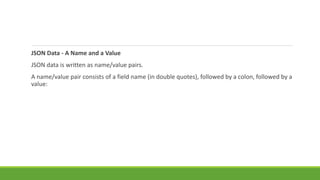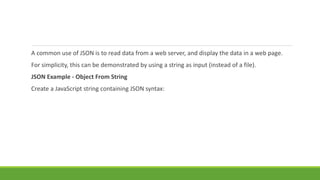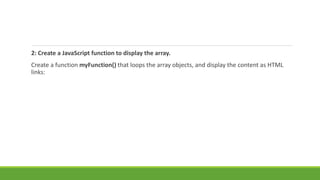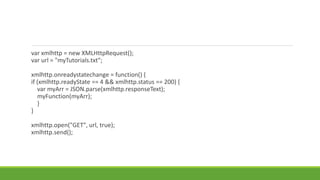JSON(JavaScript Object Notation)
- 2. JSON: JavaScript Object Notation. JSON is a syntax for storing and exchanging data. JSON is an easier-to-use alternative to XML.
- 3. JSON Example {"employees":[ {"firstName":"John", "lastName":"Doe"}, {"firstName":"Anna", "lastName":"Smith"}, {"firstName":"Peter", "lastName":"Jones"} ]}
- 4. The following XML example also defines an employees object with 3 employee records: <employees> <employee> <firstName>John</firstName> <lastName>Doe</lastName> </employee> <employee> <firstName>Anna</firstName> <lastName>Smith</lastName> </employee> <employee> <firstName>Peter</firstName> <lastName>Jones</lastName> </employee> </employees>
- 5. JSON - Evaluates to JavaScript Objects The JSON format is syntactically identical to the code for creating JavaScript objects. Because of this similarity, instead of using a parser (like XML does), a JavaScript program can use standard JavaScript functions to convert JSON data into native JavaScript objects.
- 6. JSON Example <!DOCTYPE html> <html> <body> <h2>JSON Object Creation in JavaScript</h2> <p id="demo"></p> <script> var text = '{"name":"John Johnson","street":"Oslo West 16","phone":"555 1234567"}'; var obj = JSON.parse(text); document.getElementById("demo").innerHTML = obj.name + "<br>" + obj.street + "<br>" + obj.phone; </script> </body> </html>
- 7. JSON Syntax Rules JSON syntax is derived from JavaScript object notation syntax: Data is in name/value pairs Data is separated by commas Curly braces hold objects Square brackets hold arrays
- 8. JSON Data - A Name and a Value JSON data is written as name/value pairs. A name/value pair consists of a field name (in double quotes), followed by a colon, followed by a value:
- 10. JSON Objects JSON objects are written inside curly braces. Just like JavaScript, JSON objects can contain multiple name/values pairs:
- 12. JSON Arrays JSON arrays are written inside square brackets. Just like JavaScript, a JSON array can contain multiple objects:
- 14. In the example above, the object "employees" is an array containing three objects. Each object is a record of a person (with a first name and a last name).
- 15. JSON Uses JavaScript Syntax Because JSON syntax is derived from JavaScript object notation, very little extra software is needed to work with JSON within JavaScript. With JavaScript you can create an array of objects and assign data to it, like this:
- 16. var employees = [ {"firstName":"John", "lastName":"Doe"}, {"firstName":"Anna", "lastName":"Smith"}, {"firstName":"Peter","lastName": "Jones"} ];
- 17. employees[0].firstName + " " + employees[0].lastName;
- 18. employees[0]["firstName"] + " " + employees[0]["lastName"];
- 19. A common use of JSON is to read data from a web server, and display the data in a web page. For simplicity, this can be demonstrated by using a string as input (instead of a file). JSON Example - Object From String Create a JavaScript string containing JSON syntax:
- 20. var text = '{ "employees" : [' + '{ "firstName":"John" , "lastName":"Doe" },' + '{ "firstName":"Anna" , "lastName":"Smith" },' + '{ "firstName":"Peter" , "lastName":"Jones" } ]}'; JSON syntax is a subset of JavaScript syntax. The JavaScript function JSON.parse(text) can be used to convert a JSON text into a JavaScript object:
- 21. var obj = JSON.parse(text);
- 22. <p id="demo"></p> <script> document.getElementById("demo").innerHTML = obj.employees[1].firstName + " " + obj.employees[1].lastName; </script>
- 23. Using eval() Older browsers without the support for the JavaScript function JSON.parse() can use the eval() function to convert a JSON text into a JavaScript object: var obj = eval ("(" + text + ")");
- 24. JSON Http Request A common use of JSON is to read data from a web server, and display the data in a web page. This chapter will teach you, in 4 easy steps, how to read JSON data, using XMLHttp.
- 25. <div id="id01"></div> <script> var xmlhttp = new XMLHttpRequest(); var url = "myTutorials.txt"; xmlhttp.onreadystatechange = function() { if (xmlhttp.readyState == 4 && xmlhttp.status == 200) { var myArr = JSON.parse(xmlhttp.responseText); myFunction(myArr); } } xmlhttp.open("GET", url, true); xmlhttp.send(); function myFunction(arr) { var out = ""; var i; for(i = 0; i < arr.length; i++) { out += '<a href="' + arr[i].url + '">' + arr[i].display + '</a><br>'; } document.getElementById("id01").innerHTML = out; } </script>
- 26. Example Explained 1: Create an array of objects. Use an array literal to declare an array of objects. Give each object two properties: display and url. Name the array myArray:
- 27. var myArray = [ { "display": "JavaScript Tutorial", "url": "http://www.w3schools.com/js/default.asp" }, { "display": "HTML Tutorial", "url": "http://www.w3schools.com/html/default.asp" }, { "display": "CSS Tutorial", "url": "http://www.w3schools.com/css/default.asp" } ]
- 28. 2: Create a JavaScript function to display the array. Create a function myFunction() that loops the array objects, and display the content as HTML links:
- 29. function myFunction(arr) { var out = ""; var i; for(i = 0; i < arr.length; i++) { out += '<a href="' + arr[i].url + '">' + arr[i].display + '</a><br>'; } document.getElementById("id01").innerHTML = out; }
- 31. 3: Create a text file Put the array literal in a file named myTutorials.txt: [ { "display": "JavaScript Tutorial", "url": "http://www.w3schools.com/js/default.asp" }, { "display": "HTML Tutorial", "url": "http://www.w3schools.com/html/default.asp" }, { "display": "CSS Tutorial", "url": "http://www.w3schools.com/css/default.asp" } ]
- 32. 4: Read the text file with an XMLHttpRequest Write an XMLHttpRequest to read the text file, and use myFunction() to display the array:
- 33. var xmlhttp = new XMLHttpRequest(); var url = "myTutorials.txt"; xmlhttp.onreadystatechange = function() { if (xmlhttp.readyState == 4 && xmlhttp.status == 200) { var myArr = JSON.parse(xmlhttp.responseText); myFunction(myArr); } } xmlhttp.open("GET", url, true); xmlhttp.send();
- 34. <div id="id01"></div> <script> function myFunction(arr) { var out = ""; var i; for(i = 0; i<arr.length; i++) { out += '<a href="' + arr[i].url + '">' + arr[i].display + '</a><br>'; } document.getElementById("id01").innerHTML = out; } </script> <script src="myTutorials.js"></script>
- 35. var myArray = [ { "display": "JavaScript Tutorial", "url": "http://www.w3schools.com/js/default.asp" }, { "display": "HTML Tutorial", "url": "http://www.w3schools.com/html/default.asp" }, { "display": "CSS Tutorial", "url": "http://www.w3schools.com/css/default.asp" } ]
- 36. function myFunction(arr) { var out = ""; var i; for(i = 0; i < arr.length; i++) { out += '<a href="' + arr[i].url + '">' + arr[i].display + '</a><br>'; } document.getElementById("id01").innerHTML = out; }
- 37. myFunction([ { "display": "JavaScript Tutorial", "url": "http://www.w3schools.com/js/default.asp" }, { "display": "HTML Tutorial", "url": "http://www.w3schools.com/html/default.asp" }, { "display": "CSS Tutorial", "url": "http://www.w3schools.com/css/default.asp" } ]);
- 38. myFunction([ { "display": "JavaScript Tutorial", "url": "http://www.w3schools.com/js/default.asp" }, { "display": "HTML Tutorial", "url": "http://www.w3schools.com/html/default.asp" }, { "display": "CSS Tutorial", "url": "http://www.w3schools.com/css/default.asp"" } ]);
- 39. <!DOCTYPE html> <html> <body> <h1>Customers</h1> <div id="id01"></div> <script> var xmlhttp = new XMLHttpRequest(); var url = "http://www.w3schools.com/website/customers_mysql.php"; xmlhttp.onreadystatechange=function() { if (xmlhttp.readyState == 4 && xmlhttp.status == 200) { myFunction(xmlhttp.responseText); } } xmlhttp.open("GET", url, true); xmlhttp.send(); function myFunction(response) { var arr = JSON.parse(response); var i; var out = "<table>"; for(i = 0; i < arr.length; i++) { out += "<tr><td>" + arr[i].Name + "</td><td>" + arr[i].City + "</td><td>" + arr[i].Country + "</td></tr>"; } out += "</table>" document.getElementById("id01").innerHTML = out; } </script> </body> </html>
- 40. <?php header("Access-Control-Allow-Origin: *"); header("Content-Type: application/json; charset=UTF-8"); $conn = new mysqli("myServer", "myUser", "myPassword", "Northwind"); $result = $conn->query("SELECT CompanyName, City, Country FROM Customers"); $outp = "["; while($rs = $result->fetch_array(MYSQLI_ASSOC)) { if ($outp != "[") {$outp .= ",";} $outp .= '{"Name":"' . $rs["CompanyName"] . '",'; $outp .= '"City":"' . $rs["City"] . '",'; $outp .= '"Country":"'. $rs["Country"] . '"}'; } $outp .="]"; $conn->close(); echo($outp); ?>
- 41. <!DOCTYPE html> <html> <head> <style> h1 { border-bottom:3px solid #cc9900; color: #996600; font-size: 30px; } table, th , td { border: 1px solid grey; border-collapse: collapse; padding: 5px; } table tr:nth-child(odd){ background-color: #f1f1f1; } table tr:nth-child(even){ background-color: #ffffff; } </style> </head> <body> <h1>Customers</h1> <div id="id01"></div> <script> var xmlhttp = new XMLHttpRequest(); var url = "http://www.w3schools.com/website/customers_mysql.php"; xmlhttp.onreadystatechange=function(){ if (xmlhttp.readyState == 4 && xmlhttp.status == 200) { myFunction(xmlhttp.responseText); } } xmlhttp.open("GET",url, true); xmlhttp.send(); function myFunction(response) { var arr = JSON.parse(response); var i; var out = "<table>"; for(i = 0; i < arr.length; i++) { out += "<tr><td>"+ arr[i].Name+ "</td><td>"+ arr[i].City+ "</td><td>"+ arr[i].Country+ "</td></tr>"; } out += "</table>" document.getElementById("id01").innerHTML = out; } </script> </body> </html>



![JSON Example
{"employees":[
{"firstName":"John", "lastName":"Doe"},
{"firstName":"Anna", "lastName":"Smith"},
{"firstName":"Peter", "lastName":"Jones"}
]}](https://image.slidesharecdn.com/json-150622114353-lva1-app6892/85/JSON-JavaScript-Object-Notation-3-320.jpg)









!["employees":[
{"firstName":"John", "lastName":"Doe"},
{"firstName":"Anna", "lastName":"Smith"},
{"firstName":"Peter","lastName":"Jones"}
]](https://image.slidesharecdn.com/json-150622114353-lva1-app6892/85/JSON-JavaScript-Object-Notation-13-320.jpg)


![var employees = [
{"firstName":"John", "lastName":"Doe"},
{"firstName":"Anna", "lastName":"Smith"},
{"firstName":"Peter","lastName": "Jones"}
];](https://image.slidesharecdn.com/json-150622114353-lva1-app6892/85/JSON-JavaScript-Object-Notation-16-320.jpg)
![employees[0].firstName + " " + employees[0].lastName;](https://image.slidesharecdn.com/json-150622114353-lva1-app6892/85/JSON-JavaScript-Object-Notation-17-320.jpg)
![employees[0]["firstName"] + " " + employees[0]["lastName"];](https://image.slidesharecdn.com/json-150622114353-lva1-app6892/85/JSON-JavaScript-Object-Notation-18-320.jpg)

![var text = '{ "employees" : [' +
'{ "firstName":"John" , "lastName":"Doe" },' +
'{ "firstName":"Anna" , "lastName":"Smith" },' +
'{ "firstName":"Peter" , "lastName":"Jones" } ]}';
JSON syntax is a subset of JavaScript syntax.
The JavaScript function JSON.parse(text) can be used to convert a JSON text into a JavaScript
object:](https://image.slidesharecdn.com/json-150622114353-lva1-app6892/85/JSON-JavaScript-Object-Notation-20-320.jpg)

![<p id="demo"></p>
<script>
document.getElementById("demo").innerHTML =
obj.employees[1].firstName + " " + obj.employees[1].lastName;
</script>](https://image.slidesharecdn.com/json-150622114353-lva1-app6892/85/JSON-JavaScript-Object-Notation-22-320.jpg)


![<div id="id01"></div>
<script>
var xmlhttp = new XMLHttpRequest();
var url = "myTutorials.txt";
xmlhttp.onreadystatechange = function() {
if (xmlhttp.readyState == 4 && xmlhttp.status == 200) {
var myArr = JSON.parse(xmlhttp.responseText);
myFunction(myArr);
}
}
xmlhttp.open("GET", url, true);
xmlhttp.send();
function myFunction(arr) {
var out = "";
var i;
for(i = 0; i < arr.length; i++) {
out += '<a href="' + arr[i].url + '">' +
arr[i].display + '</a><br>';
}
document.getElementById("id01").innerHTML = out;
}
</script>](https://image.slidesharecdn.com/json-150622114353-lva1-app6892/85/JSON-JavaScript-Object-Notation-25-320.jpg)

![var myArray = [
{
"display": "JavaScript Tutorial",
"url": "http://www.w3schools.com/js/default.asp"
},
{
"display": "HTML Tutorial",
"url": "http://www.w3schools.com/html/default.asp"
},
{
"display": "CSS Tutorial",
"url": "http://www.w3schools.com/css/default.asp"
}
]](https://image.slidesharecdn.com/json-150622114353-lva1-app6892/85/JSON-JavaScript-Object-Notation-27-320.jpg)

![function myFunction(arr) {
var out = "";
var i;
for(i = 0; i < arr.length; i++) {
out += '<a href="' + arr[i].url + '">' + arr[i].display + '</a><br>';
}
document.getElementById("id01").innerHTML = out;
}](https://image.slidesharecdn.com/json-150622114353-lva1-app6892/85/JSON-JavaScript-Object-Notation-29-320.jpg)

![3: Create a text file
Put the array literal in a file named myTutorials.txt:
[
{
"display": "JavaScript Tutorial",
"url": "http://www.w3schools.com/js/default.asp"
},
{
"display": "HTML Tutorial",
"url": "http://www.w3schools.com/html/default.asp"
},
{
"display": "CSS Tutorial",
"url": "http://www.w3schools.com/css/default.asp"
}
]](https://image.slidesharecdn.com/json-150622114353-lva1-app6892/85/JSON-JavaScript-Object-Notation-31-320.jpg)


![<div id="id01"></div>
<script>
function myFunction(arr) {
var out = "";
var i;
for(i = 0; i<arr.length; i++) {
out += '<a href="' + arr[i].url + '">' + arr[i].display + '</a><br>';
}
document.getElementById("id01").innerHTML = out;
}
</script>
<script src="myTutorials.js"></script>](https://image.slidesharecdn.com/json-150622114353-lva1-app6892/85/JSON-JavaScript-Object-Notation-34-320.jpg)
![var myArray = [
{
"display": "JavaScript Tutorial",
"url": "http://www.w3schools.com/js/default.asp"
},
{
"display": "HTML Tutorial",
"url": "http://www.w3schools.com/html/default.asp"
},
{
"display": "CSS Tutorial",
"url": "http://www.w3schools.com/css/default.asp"
}
]](https://image.slidesharecdn.com/json-150622114353-lva1-app6892/85/JSON-JavaScript-Object-Notation-35-320.jpg)
![function myFunction(arr) {
var out = "";
var i;
for(i = 0; i < arr.length; i++) {
out += '<a href="' + arr[i].url + '">' + arr[i].display +
'</a><br>';
}
document.getElementById("id01").innerHTML = out;
}](https://image.slidesharecdn.com/json-150622114353-lva1-app6892/85/JSON-JavaScript-Object-Notation-36-320.jpg)
![myFunction([
{
"display": "JavaScript Tutorial",
"url": "http://www.w3schools.com/js/default.asp"
},
{
"display": "HTML Tutorial",
"url": "http://www.w3schools.com/html/default.asp"
},
{
"display": "CSS Tutorial",
"url": "http://www.w3schools.com/css/default.asp"
}
]);](https://image.slidesharecdn.com/json-150622114353-lva1-app6892/85/JSON-JavaScript-Object-Notation-37-320.jpg)
![myFunction([
{
"display": "JavaScript Tutorial",
"url": "http://www.w3schools.com/js/default.asp"
},
{
"display": "HTML Tutorial",
"url": "http://www.w3schools.com/html/default.asp"
},
{
"display": "CSS Tutorial",
"url": "http://www.w3schools.com/css/default.asp""
}
]);](https://image.slidesharecdn.com/json-150622114353-lva1-app6892/85/JSON-JavaScript-Object-Notation-38-320.jpg)
![<!DOCTYPE html>
<html>
<body>
<h1>Customers</h1>
<div id="id01"></div>
<script>
var xmlhttp = new XMLHttpRequest();
var url = "http://www.w3schools.com/website/customers_mysql.php";
xmlhttp.onreadystatechange=function() {
if (xmlhttp.readyState == 4 && xmlhttp.status == 200) {
myFunction(xmlhttp.responseText);
}
}
xmlhttp.open("GET", url, true);
xmlhttp.send();
function myFunction(response) {
var arr = JSON.parse(response);
var i;
var out = "<table>";
for(i = 0; i < arr.length; i++) {
out += "<tr><td>" +
arr[i].Name +
"</td><td>" +
arr[i].City +
"</td><td>" +
arr[i].Country +
"</td></tr>";
}
out += "</table>"
document.getElementById("id01").innerHTML = out;
}
</script>
</body>
</html>](https://image.slidesharecdn.com/json-150622114353-lva1-app6892/85/JSON-JavaScript-Object-Notation-39-320.jpg)
![<?php
header("Access-Control-Allow-Origin: *");
header("Content-Type: application/json; charset=UTF-8");
$conn = new mysqli("myServer", "myUser", "myPassword", "Northwind");
$result = $conn->query("SELECT CompanyName, City, Country FROM Customers");
$outp = "[";
while($rs = $result->fetch_array(MYSQLI_ASSOC)) {
if ($outp != "[") {$outp .= ",";}
$outp .= '{"Name":"' . $rs["CompanyName"] . '",';
$outp .= '"City":"' . $rs["City"] . '",';
$outp .= '"Country":"'. $rs["Country"] . '"}';
}
$outp .="]";
$conn->close();
echo($outp);
?>](https://image.slidesharecdn.com/json-150622114353-lva1-app6892/85/JSON-JavaScript-Object-Notation-40-320.jpg)
![<!DOCTYPE html>
<html>
<head>
<style>
h1 {
border-bottom:3px solid #cc9900;
color: #996600;
font-size: 30px;
}
table, th , td {
border: 1px solid grey;
border-collapse: collapse;
padding: 5px;
}
table tr:nth-child(odd){
background-color: #f1f1f1;
}
table tr:nth-child(even){
background-color: #ffffff;
}
</style>
</head>
<body>
<h1>Customers</h1>
<div id="id01"></div>
<script>
var xmlhttp = new XMLHttpRequest();
var url = "http://www.w3schools.com/website/customers_mysql.php";
xmlhttp.onreadystatechange=function(){
if (xmlhttp.readyState == 4 && xmlhttp.status == 200) {
myFunction(xmlhttp.responseText);
}
}
xmlhttp.open("GET",url, true);
xmlhttp.send();
function myFunction(response) {
var arr = JSON.parse(response);
var i;
var out = "<table>";
for(i = 0; i < arr.length; i++) {
out += "<tr><td>"+
arr[i].Name+
"</td><td>"+
arr[i].City+
"</td><td>"+
arr[i].Country+
"</td></tr>";
}
out += "</table>"
document.getElementById("id01").innerHTML = out;
}
</script>
</body>
</html>](https://image.slidesharecdn.com/json-150622114353-lva1-app6892/85/JSON-JavaScript-Object-Notation-41-320.jpg)